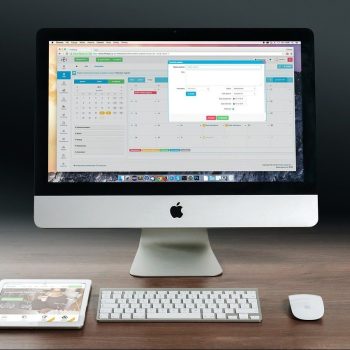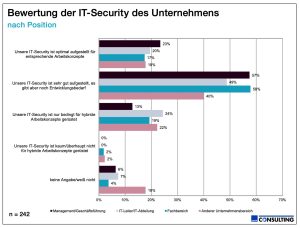
The security provider Ivanti has presented the results of a study on security in the digital workplace. This makes it clear: IT has created the digital workplace - but now it is important to protect it against new attack vectors. 24% of those responsible for IT believe that IT security is only partially equipped for the digital workplace.
In fact, when it comes to IT security in the remote working world, there is still room for improvement, even if management sometimes takes a different position than IT.
Lack of IT influence on the design of the digital workplace
Basically, the study suggests that the digital workplace in the form of a hybrid workplace is popular. Two thirds of all those surveyed (66%) want this concept, which was established during the corona pandemic, to continue in the future. However, when it comes to the topics of "design" and "safety", there is far less agreement. An example: When asked who is primarily responsible for driving a hybrid workplace strategy, 82% of the managers surveyed defined themselves. However, only just under half of those surveyed (49%) from the IT department confirmed this assessment. In contrast, 34% of IT experts see themselves as responsible. Just 8% of management shares this view.
The perspective on how well IT is already involved in decisions also differs: 35% of the managers surveyed say that the role of the IT department has changed and that it is much more involved in strategic processes/decisions. But only 15% of respondents from IT see it that way. For a secure design of hybrid working environments, however, the expertise of the IT department would be necessary.
Compromises when it comes to security
The future of the digital workplace is based on mobile hardware to work from anywhere. It is all the more surprising that a total of 24% of those surveyed rated the equipment in the area of mobile device management/enterprise mobility management as only "satisfactory", 8% even rated it as "very bad". When it comes to IT security hardware, 78% of the managers surveyed rated the equipment as “good” or “very good”, while only two-thirds (66%) of the IT experts said so. 27% of them, on the other hand, rate the equipment with IT security hardware as satisfactory. So while the management level sees their organization in a better position, the IT experts remain more cautious.
Management relies on reactive security technologies

24% of those responsible for IT believe that IT security is only partially equipped for the digital workplace (Image: ivanti).
A quarter of IT managers (24%) believe that IT security is only partially equipped for the digital workplace. At management level, on the other hand, more than half (57%) of those surveyed are of the opinion that IT security is very well positioned, but that there is still room for improvement.
When it comes to technology for IT security, there are similar differences, but they are much less pronounced. The management tends to rely on security technologies that are able to restore data after an attack, such as backup & data security (32% management, 17% IT department). IT, on the other hand, is more in favor of technologies that prevent attacks on employees (mobile device management: 12% IT, 9% management) and access and identity management (22% IT, 19% management). Preventive training for employees, on the other hand, is rated equally highly by both groups (34% IT, 32% management).
Zero Trust or MFA hasn't arrived yet
These results should be viewed critically, especially with a view to the future task of securing remote working environments. Because modern security concepts such as zero trust, passwordless multi-factor authentication (MFA) or role-based access control that includes the location of the user are still not sufficiently anchored in the executive suites or in the IT teams. Here, IT can play a pioneering role and distinguish itself through forward-looking security strategies in the company.
This also becomes clear with a view to the future of the digital workplace. For example, 13% of the managers surveyed absolutely agree that their company is planning significant investments in the technical setup of modern digital workplaces in the current year and next, while only 2% of the IT experts share this view.
Study shows lack of management understanding
"The study sheds an interesting light on the sometimes significant differences in perception between management and IT teams with regard to securing digital workplace structures," explains Johannes Carl, Expert Manager PreSales - UEM at Ivanti. “While the executive level sees their organization generally well positioned, the IT experts remain more reserved. It remains to be seen whether this is due to a lack of management understanding of the necessary technology concepts or whether the competence of the organization is simply overestimated. However, the latter would be serious. Because the digital workplace creates new attack vectors that can only be closed with consistent mobile security concepts such as zero trust security and biometric authentication processes. Here, IT is even more required to seek close exchange with the management and to position itself as a strategic partner.”
The digital workplace is here to stay. In the coming months, IT & IT security teams will have to intensify the work of the last 24 months and not only make hybrid forms of work possible, but above all secure them. Zero Trust Access, Mobile Threat Defense and Identity Management support this.
More at ivanti.com
About Ivanti The strength of unified IT. Ivanti connects IT with security operations in the company in order to better control and secure the digital workplace. We identify IT assets on PCs, mobile devices, virtualized infrastructures or in the data center - regardless of whether they are hidden on-premise or in the cloud. Ivanti improves the provision of IT services and reduces risks in the company on the basis of specialist knowledge and automated processes. By using modern technologies in the warehouse and across the entire supply chain, Ivanti helps companies improve their ability to deliver - without changing the backend systems.
